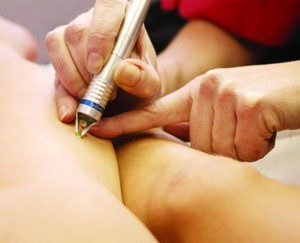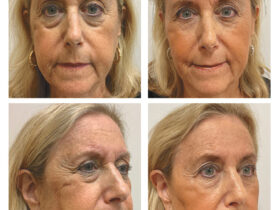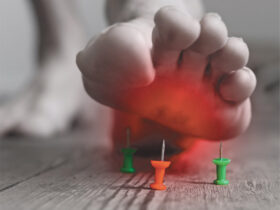By John P. Landi, MD, FACS, RPVI, RPhS, – Diplomate of The American Board of Venous and Lymphatic Medicine –
 Varicose Veins and Spider Veins are conditions that affect millions of people. Besides creating an unsightly appearance in the legs, they can also cause significant medical problems including cramping, aching and swelling of the legs, as well as night cramps, bleeding from Varicose or Spider Veins and even ulcerations of the leg.
Varicose Veins and Spider Veins are conditions that affect millions of people. Besides creating an unsightly appearance in the legs, they can also cause significant medical problems including cramping, aching and swelling of the legs, as well as night cramps, bleeding from Varicose or Spider Veins and even ulcerations of the leg.
Treatment of Varicose and Spider Veins has changed drastically over the last ten years. A decade ago the only treatment for Varicose Veins was a radical surgical procedure called “Stripping of the Veins” which involved multiple incisions and subsequently multiple stitches and the end result was replacing a vein with a scar. Similarly the only treatment for Spider Veins ten years ago was injecting them with a saline solution which was very irritating and fraught with multiple complications, including discoloration of the skin called staining, ulceration of the skin and recurrence of the veins. Both the treatment of Varicose and Spider Veins has changed drastically and now the state of the art treatment for Varicose Veins is a procedure called Closure in which the valves of the veins are closed with either a laser directed filament or a Radio Frequency directed catheter. As far as Spider Veins are concerned the current state of the art treatment for these is Sclerotherapy with a Foamed Solution.
Laser stands for Light Amplification by Stimulated Emission of Radiation. What this essentially means is that a wavelength of light is generated by a Laser instrument. This light then penetrates through the skin to focus on a specific structure which results in the structure being heated and ultimately dissolved. In laser therapy for veins the lasers that are used have wavelengths that are specific for the hemoglobin (blood). Thus, the blood is heated and dissolved. At the same time the heat from the laser also destroys the wall or lining of the vein causing it to disintegrate.
There are multiple lasers used to dissolve veins and a common misunderstanding is that the same laser is used to treat all kinds of veins. Veins that are under the skin are treated by a particular kind of laser and Spider Veins on the skin by a totally different laser.
In general, veins under the skin, specifically the Saphenous Veins, are treated by a procedure called Closure. This could be done either with a laser filament or Radio Frequency Catheter. Although the Radio Frequency Catheter is not a true laser the principal is the same in that the filament is placed inside the Saphenous Vein and the heat form the Radio Frequency waves destroys the lining of the wall casing it to evaporate.
The current state of the art treatment of Varicose Veins is by a technique called Closure. The main problem in the formation of Varicose Veins and frequently in the formation of Spider Veins is that the valves in the Saphenous Vein System do not close properly. The Saphenous System is a superficial system. Blood travels form the foot up the Saphenous Vein through the valves. If the valves do not close properly then blood cannot pass through the valves and, subsequently, passes around the valve through the skin to form Varicose and Spider Veins. If this is the case then the valves need to be sealed or closed and this could be done with the laser or Radio Frequency Filament. Once the valves are closed then the blood that would be passing around the valves into the skin is now pushed by the contraction of muscles in the leg into the deeper veins. There are many lasers available in varying wavelengths to close the Saphenous Vein System, and although there is some controversy as to what is the best laser to use, in reality, most of the standard lasers available work well.
Spider Veins on the other hand are best treated by Sclerotherpay. A common misconception that I see often is that patients want to have their Spider Veins treated with the laser. One must remember that treating Spider Veins with a laser requires a skin laser not a deep laser. Skin lasers in general work very poorly on Spider Veins.
The gold standard for Spider Vein Treatment is injection Sclerotherapy. Only those veins which are smaller than the Sclerotherapy needle are veins that should be treated with a skin laser and skin lasers do not work very well to eradicate Spider Veins. Skin laser vein treatment requires multiple treatments, is painful and is expensive.
In summary, the treatment of Varicose and Spider Veins has undergone a drastic evolution in the last decade. The current gold standard for the treatment of veins is to do an ultrasound to see if valves are incompetent and if the valves are incompetent, then these should be first closed either with the laser or radio frequency filament.
Varicose Veins can then be treated by either injection Sclerotherapy or a procedure called Microphlebectomy which involves tiny pinholes to disconnect or remove the vein. In reference to Spider Veins, patients should still undergo an ultrasound to document whether or not the valves are leaking. If the valves are leaking they should be closed so as to increase the efficacy of the Sclerotherapy. Spider Veins are best treated by Sclerotherapy techniques and lasering on Spider Veins is a last resort and a poor second best in comparison to Sclerotherapy.
Dr. John P. Landi is medical director of Vanish Vein and Laser Center, a state of the art, dedicated vein treatment center. He is one of less than 2,000 physicians worldwide to achieve the designation of Diplomate of the American Board of Venous and Lymphatic Medicine. He is a fellow of the American College of Surgeons, a fellowship trained vascular surgeon, Board Certified in General Surgery and has achieved both the RPVI and RPhS certifications in vascular ultrasound.
239-403-0800 | www.VanishVein.com









